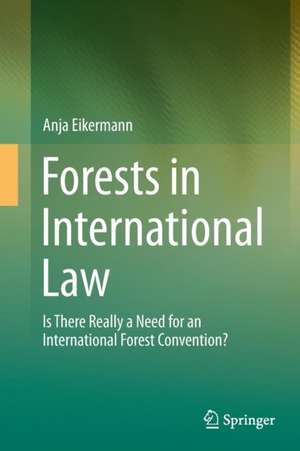Forests in International Law: Is There Really a Need for an International Forest Convention?
Autor Anja Eikermannen Limba Engleză Paperback – 6 oct 2016
| Toate formatele și edițiile | Preț | Express |
|---|---|---|
| Paperback (1) | 383.12 lei 6-8 săpt. | |
| Springer International Publishing – 6 oct 2016 | 383.12 lei 6-8 săpt. | |
| Hardback (1) | 390.25 lei 6-8 săpt. | |
| Springer International Publishing – 6 mar 2015 | 390.25 lei 6-8 săpt. |
Preț: 383.12 lei
Nou
Puncte Express: 575
Preț estimativ în valută:
73.31€ • 79.88$ • 61.77£
73.31€ • 79.88$ • 61.77£
Carte tipărită la comandă
Livrare economică 23 aprilie-07 mai
Preluare comenzi: 021 569.72.76
Specificații
ISBN-13: 9783319368139
ISBN-10: 3319368133
Pagini: 206
Ilustrații: X, 196 p.
Dimensiuni: 155 x 235 x 11 mm
Greutate: 0.3 kg
Ediția:Softcover reprint of the original 1st ed. 2015
Editura: Springer International Publishing
Colecția Springer
Locul publicării:Cham, Switzerland
ISBN-10: 3319368133
Pagini: 206
Ilustrații: X, 196 p.
Dimensiuni: 155 x 235 x 11 mm
Greutate: 0.3 kg
Ediția:Softcover reprint of the original 1st ed. 2015
Editura: Springer International Publishing
Colecția Springer
Locul publicării:Cham, Switzerland
Cuprins
State of Research and Structure of the Book.- The Case for International Forest Regulation – The Benefits and Challenges of the Multifunctional Concept of Forests.- Agenda-Setting and Institution Building for Forests – Entangled Structures and the Failure of Legalization.- The Treaty Canopy – General, International Environmental and International Economic Law Covering Forests.- The Options for an International Regulation of Forests.- Conclusions.- Summary.
Textul de pe ultima copertă
This book investigates the potential need for an international convention on forests and establishes a multifunctional concept of forests as a cornerstone for international forest regulation. Accordingly, it examines a variety of international instruments pertaining directly or indirectly to forests and explores their entangled, fragmented nature. While contending that the lack of consistency in international law impedes the development of a stand-alone international forest convention, at the same time it argues that the lessons learned from fragmentation as well as from the history of forest discourse on the international level open up new options for the regulation of forests in international law, based on (new) concepts of coordination and cooperation.
Caracteristici
Provides for a comprehensive analysis of the international instruments covering forests Goes beyond a mere analysis of the reasons for the failure of an international forest convention Focusses on the fragmentation of international law for problem analysis as well as problem solving















